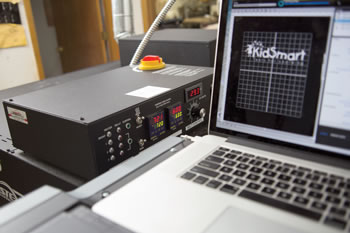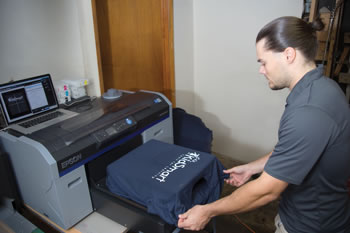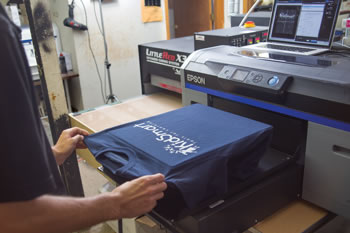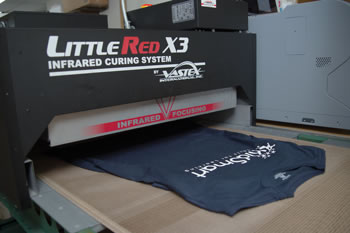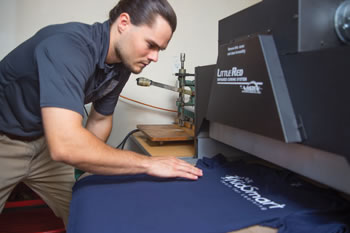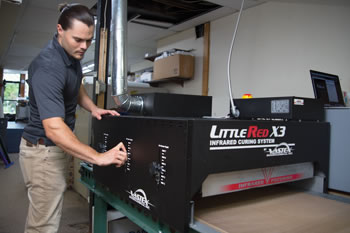ST. LOUIS, MO — C&C Quality Printing, Inc. has grown from a small offset printer to an advanced, full-service print shop. Founded in 1978 by Mirko Coric, the company is now run by his son, Maximus Coric, who says that C&C's mom-and-pop mindset has never changed.
He points to an example on press: fourth-generation wedding invitations for a family that first came through C&C's doors in the late 70s. "We printed wedding invitations for the great-grandmother, the grandmother, the mother, and recently for the daughter," says Coric. "Our tagline is 'welcome to the family,' and it's the family nature of our business that allows us to build trusting relationships with our customers."
In the early 90s, the father-son duo began to diversify, branching into vinyl cutting and vehicle graphics. Next, C&C purchased a manual screen printing press and began printing yard signs, T-shirts, and other garments. As print technologies advanced, the shop added one of the first direct-to-garment (DTG) printers.
DTG printing expands options
Coric considers manual screen printing ideal for identical designs consisting of one or two colors: "It captures economies of scale and scope to make the per-piece cost extremely low," he says. "The more you print, the more you save."
Conversely, he says multicolor garments were more time-consuming and costly to produce on the manual press because they required prepress equipment to produce a screen for each color.
To better customize orders and print on demand, Coric purchased a direct-to-garment (DTG) inkjet printer. After processing the artwork on a computer, the design is printed directly onto the surface of the garment using aqueous-based pigmented ink, which the garment's fibers absorb. DTG printing allows for thousands of colors and gradients, making it suitable for printing of full-color photographs.
"DTG printing is very versatile," says Coric. "Since there are no screens, each graphic is sent to the printer digitally, so you can have variable data in the form of several different files. We have the flexibility to print 100 shirts with 100 different prints, and we're able to charge more because people want that customization."
Infrared conveyor dryer corrects compromised curing
"Printed shirts looked amazing when they came off the inkjet printer," Coric says, "but when they were transferred to the heat press for curing, the press muted the colors and made them look muddy. I had to sell them at a discount just to get rid of them. I knew there had to be a better way to cure the shirts."
Then at a trade show, Coric saw a demonstration of an infrared conveyor dryer developed specifically for DTG-printed textiles called a "LittleRed® X3D." He purchased the dryer and reports a three-month payback, saying, "Because our shirts looked great, we were able to command higher prices for them."
Manufactured by Vastex International, the dryer can cure screen printed plastisol, water-based and discharge inks, but it offers a special "pre-heating" function that also allows rapid curing of white water-based inks printed digitally, including garments simultaneously pretreated on Kornit® machines.
The unit's key difference is an intense pre-heating zone that surges the ink temperature to over 300°F within the first several inches of conveyor travel, maximizing the time the image spends at its optimum curing temperature before exiting the heating chamber (see sidebar).
The dryer is equipped with a 30 in. (76 cm) wide conveyor belt with three 24 in. (61 cm) wide infrared heaters that are height adjustable, allowing Coric to position images at a consistent distance from the heaters whether printed on T-shirts, sweatshirts or sweatpants.
"I used to have to wait for the heat press, and had to buy a second one just to keep up with the digital printer," says Coric. "Now, with the high-density infrared dryer, we're waiting for the shirts to come off the printer.
"The maximum temperature of the heat press was about half that of the LittleRed's temperature," he says. "Now, we're able to heat the shirts up quickly. The heating process actually turns the pigment into a gas that permeates the pores of the shirt, thereby setting the image that much better."
In the minute that it took to cure one shirt on the heat press, the DTG dryer can cure six to eight shirts. Most important to Coric, however, is enhanced quality. "Ink adhesion has improved and designs are clear and crisp with vibrant colors," he explains.
Quality shirts boost sales
C&C Quality Printing has occupied the same 2,000 sq ft (186 sq m) retail space since 1992 — just six doors down from its original location. Despite the company's expansion, Coric says he has no plans to move to a larger facility.
"We want our customers to feel comfortable with us," he says. "They know where to find us, and they know when they come to the store that we're there for them."
In addition to the DTG printer and the infrared conveyor dryer, Coric's shop has three digital high-speed printers, a latex printer for large-format printing, embroidery machines and a binding department, as well as creasing, cutting, perforating and UV coating services. He also offers offset and screen printing services at an off-site facility.
Coric says he may use the infrared conveyor dryer for other curing purposes in the future-or he may purchase a second unit for use at his screen printing facility. But for now, the X3D dryer remains tethered to the DTG printer.
"For us, the dryer brought life to DTG printing," he says. "We're able to get those bright, vibrant colors, and they stay that way. It's gained a lot of attention, and it's bringing in more customers. Before, it was hard to sell the shirts. Now I'm able to command a premium."









